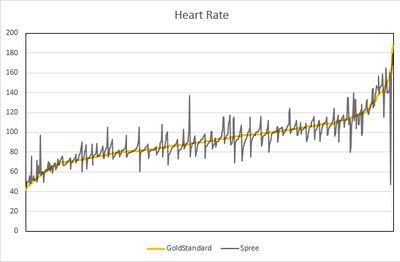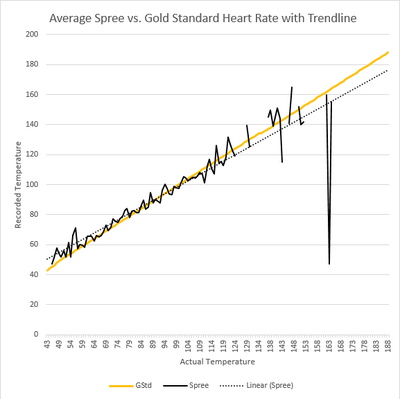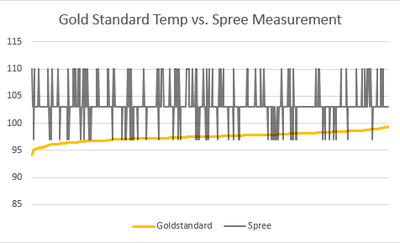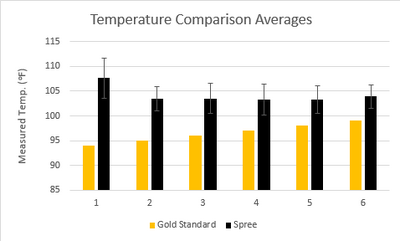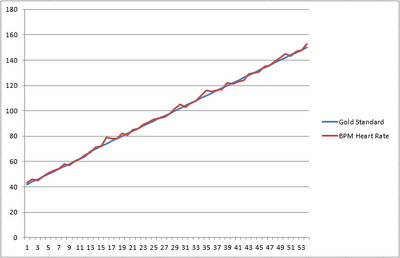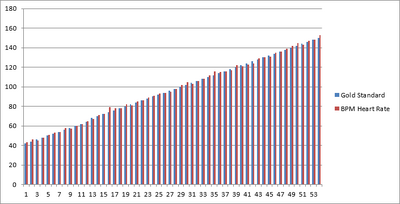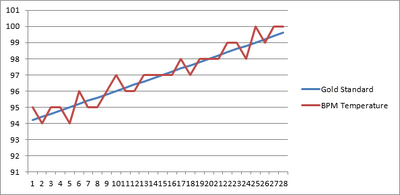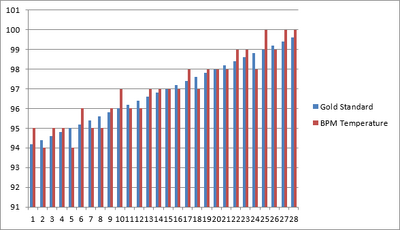BME100 f2014:Group19 L3
| Home People Lab Write-Up 1 | Lab Write-Up 2 | Lab Write-Up 3 Lab Write-Up 4 | Lab Write-Up 5 | Lab Write-Up 6 Course Logistics For Instructors Photos Wiki Editing Help | ||||||||||||||||||||||||||||||
|
OUR TEAM
LAB 3A WRITE-UPDescriptive Statistics"Gold Standard" Mean Heart Rate: 92.6 bpm "Gold Standard" Heart Rate Standard Deviation: 21.5 bpm "Gold Standard" Heart Rate Standard Error: 0.87 bpm Spree Band Mean Heart Rate: 93.0 bpm Spree Band Heart Rate Standard Deviation: 21.7 bpm Spree Band Heart Rate Standard Error: 0.87 bpm "Gold Standard" Mean Temperature: 97.5 F "Gold Standard" Temperature Standard Deviation: 0.86 F "Gold Standard" Temperature Standard Error: 0.032 F Spree Band Mean Temperature: 103.4 F Spree Band Temperature Standard Deviation: 2.9 F Spree Band Temperature Standard Error: 0.11 F
Results[Graph 1.1: Variance in Spree Readings as Heart Rate Increases] [Graph 1.2: Average Spree Readings for Gold Standard Measurement Groups] [Graph 1.3: Average Spree Value per Gold Standard Degree Change] [Graph 2.1: Gold Standard Temperature vs. Spree Measurement] [Graph 2.2: Temperature Comparison Averages] Pearson R (Temp): -0.01689 Pearson R (Heart Rate): 0.903383 T-Test (Temp): 0 T-Test (Heart rate): 0.789
AnalysisThe heart rates recorded by the Spree Band show a positive correlation with the actual heart rates of the subjects being experimented upon, as recorded by a reading of a pulse oximeter, a gold standard reading device. This correlation is further supported through the Pearson R value that is approximately 1 and the T-Test value of .789 that proves the data to be significant. Graph 1.1 plots the recorded Spree heart rate for every single heart rate measurement; Graph 1.3 condenses this data, averaging the Spree values that were recorded for every gold standard measurement that had the same value. (i.e. All Spree values for a Gold Standard measurement of 113 BPM were averaged to produce a single number, which was then plotted on Graph 1.3.) Based on this data, it can be said that the Spree band works most accurately for heart rates between 70 and 110 BPM; values higher and lower than this have a higher deviation than is desirable for accurate measurement. The temperature values produced by the Spree Band show no correlation with the gold standard measurements, as proven by the Pearson R value of -0.01 and the T-Test value of 0. This is most easily seen on Graph 2.1, where the Spree temperature values seem to randomly fluctuate as Gold Standard temperature values increase. The gold standard temperature accurately measured internal temperature, but for each gold standard value, the Spree band showed significantly different and varied values. The Spree Band cannot be used to measure body temperature accurately.The design is flawed and lacks the proper mechanism to provide accurate measurements.
Summary/DiscussionThe Spree Band biometrics device provides useful data to an athlete wearing it. However, it is not perfect. When compared to a medical-grade heart rate monitor, the heart rate data given by the Spree Band shows a positive correlation. While not accurate enough to be used as a replacement for the medical-grade monitor, the Spree Band provides sufficient measurements to be used by an athlete or trainer to make inferences about athletic performance and effort. The temperature sensor, however, shows no correlation with a standard oral thermometer. Because the Spree Band is placed on the forehead, it only measures the temperature of the surface of the skin; It cannot determine true core body temperature. In addition, temperature is displayed using four positions of a "gauge" instead of degrees, so even if the device was taking accurate temperature, it could not be accurately communicated to the user. The information displayed is too general.
LAB 3B WRITE-UPTarget Population and NeedOur target population is athletes. Specifically, athletes that listen to music while training or working out. Our product, BPM earphones, gives them an opportunity to monitor their heart rate and temperature without having to put on another device they would not normally use. Through the app on their phone they can monitor useful medical information while listening to music as they normally would.
Device DesignOur device is a set of earphones that wrap around the ear that monitor the heart rate and temperature of the user. The earphones come with a mobile app that allow the user to access the information on their phone as they listen to music. Not only can the user have access to the medical information but the information can then be sent directly to doctors or other trained proffessionals such as physical therapists, allowing use for rehabilitation efforts with athletes. For only 124.99, app included.
Inferential StatisticsHeart RatePearson R Value (BPM vs Gold Standard): 0.999027195 T test: 0.916626245
TemperaturePearson R Value: 0.953615498 T test: 0.828252147
The temperature values also show excellent correlation with the Gold Standard temperature measurements. The BPM device can accurately measure body temperature at its placement on the ear of an athlete.
Graphs[Graph 3.1: BPM Recordings as Gold Standard Heart Rate Recordings Increase in Value] [Graph 3.2: Average Measured BPM Heart Rate Data for specific Gold Standard Measurements] [Graph 4.1: BPM Recordings as Gold Standard Temperature Recordings Increase in Value] [Graph 4.2: Average Measured BPM Temperature Data for specific Gold Standard Measurements] |
||||||||||||||||||||||||||||||

